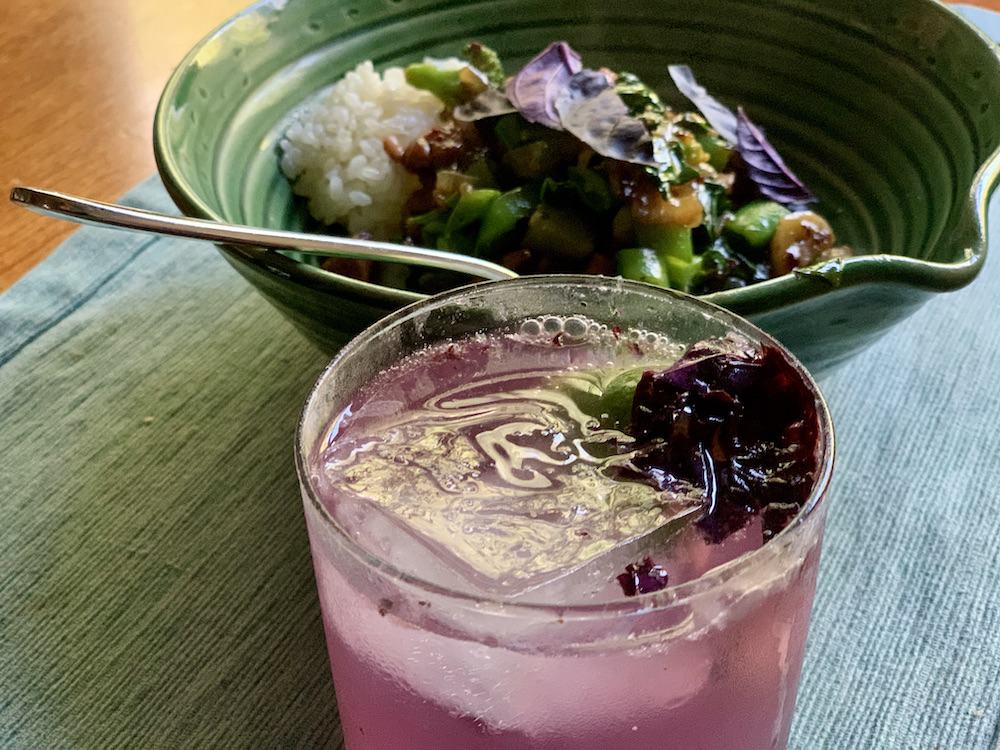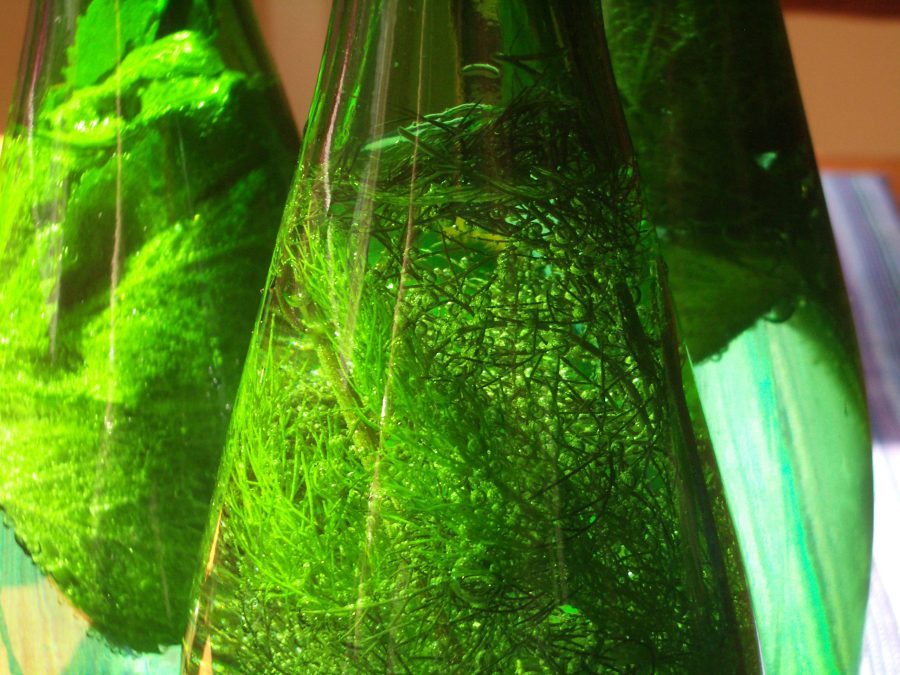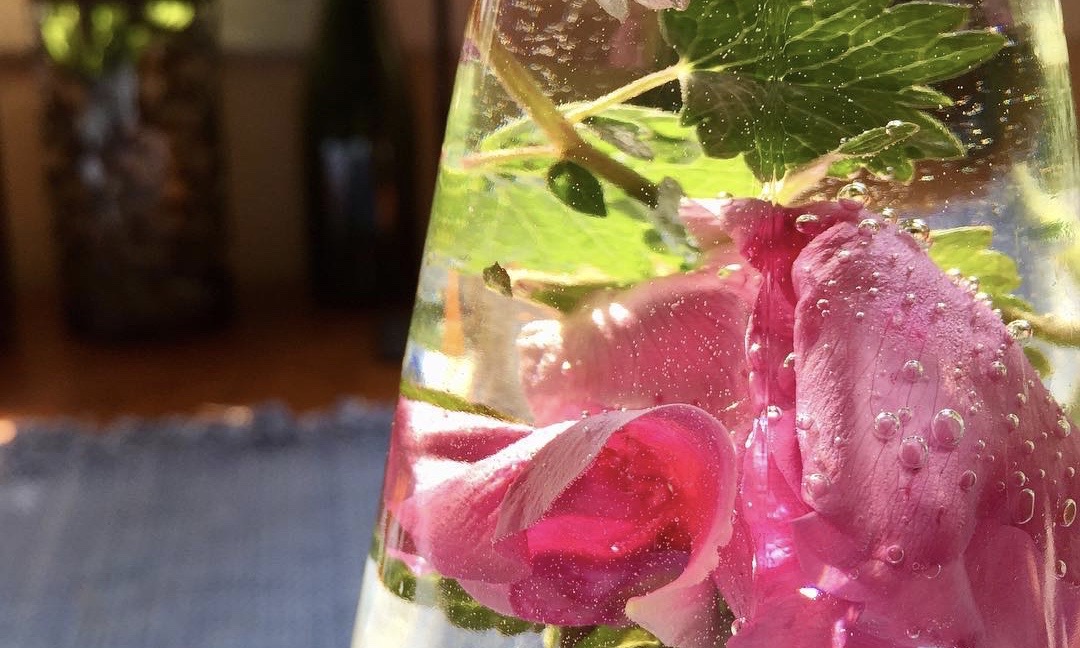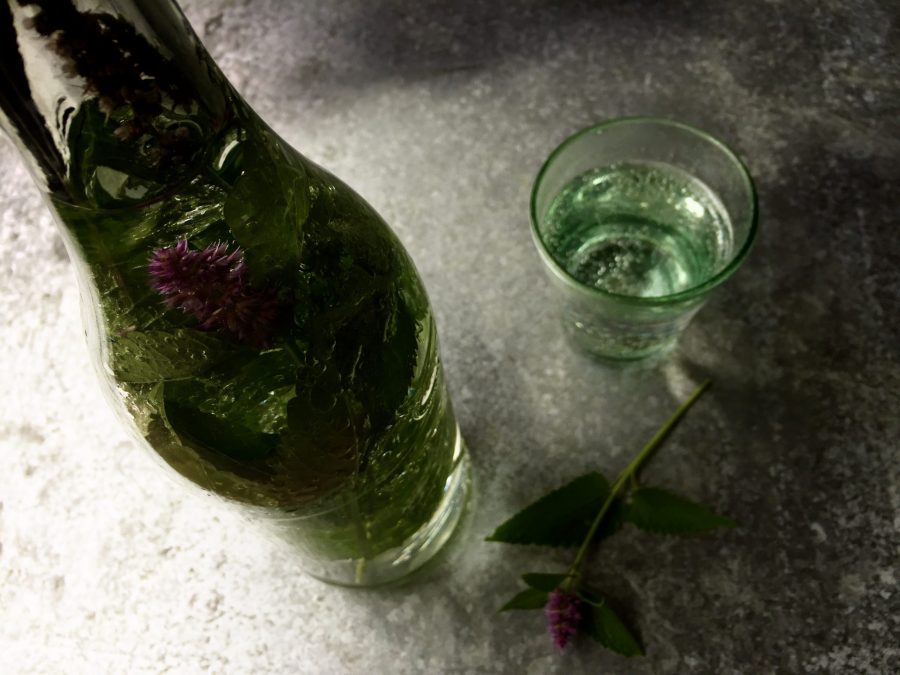Now that the growing season has kicked into full gear, take advantage of one of the easiest and most delicious ways to incorporate fresh herbs into your daily routine: infused water. You might be thinking, “You mean, herbal tea?” But, this isn’t quite the same thing. It’s glorious, refreshing, delicious, and stunning.
I sip infused water and seltzer all summer long. I quickly stuff some herbs in a glass pitcher to serve a few minutes later during client visits. Herb and fruit seltzers go great with dinner. For parties, I prep two or three varieties of seltzer bottles to enjoy and share for alcohol-free crowds and when we want to turn to something more hydrating and less caloric. On special occasions and float trips down the river, our cocktail glasses or insulated water bottles hold herbal soda (with perhaps a splash of vodka or gin). For hot yard work days, I load my thermos up with ice, herb soda (hold the booze), and a pinch of salt to stay hydrated. And, on class days, I grab whatever calls to me from the garden to put in a glass pitcher or my pour-spout glass water dispenser with ice and cold water for students. Those fancy spa waters made with sliced cucumbers or citrus slices? Infused water! It’s time to enlist your herbs for some spa-worthy hydration.

Benefits of Infused Water
- Fun and yummy
- Ridiculously easy and cheap to make
- Beautiful to look at and serve to guests
- Highlight the flavorful, aromatic properties of your herbs
- More refreshing and hydrating than tea
- More exciting than plain water
- No calories or sugar (unless you make a soda) nor alcohol, yet still special
- Only lightly medicinal, perfect for daily use
- The aromatics in flavorful herbs often uplift spirits, quell anxiety, improve focus, and/or aid digestion
Infused Water vs Tea
Generally speaking, we make tea by infusing (steeping) or decocting (boiling) herbs in hot water. This pulls a wide range of constituents from the plant including aromatics, tannins, nutrients, pigments, and more. Infused waters are made with cold or room temperature water and, in contrast, are a lighter medicinal extract focused primarily on aromatics. Infused waters tend to be light yet delicious, more like water than tea in terms of hydration, with an aromatherapy boost for your taste buds. A good example of the difference between an infused tea and water would be rose petals. If you were to make rose petal tea, it would taste quite bitter and astringent (giving your mouth that pucker-y feeling of a strongly brewed green tea) with a light hint of rose-y aroma – nice for healing gut lining and relieving mild, chronic diarrhea. When you make an infused water with roses, it becomes intensely rosey, almost perfume-y, and it lacks any underlying bitter or astringent properties. This is perfect to gladden your heart and bring joy to the day.
How To Make Them
Infused Water
It’s crazy simple. Place some fresh sprigs of herbs and/or flowers in a container of water, let them sit for a bit, then sip. Most of our garden herbs will taste great within 5 to 15 minutes, but roses and cinnamon sticks need an hour or two to really impart flavor. Refrigerate or add ice if you like, but use it up within a day because this type of beverage spoils easily. Or, you can take it up a notch to make seltzer or soda.
How To Make Herbal Seltzer & Soda
In a bubble-safe container (repurpose old seltzer or fermentation bottles that can handle the pressure of carbonation), shove in three large sprigs of herbs, cover carefully with plain seltzer. Steep, refrigerated, for 30 minutes before serving, and use it all up that day.
You can buy plain, cheap seltzer for about $1/liter at the grocery store, more for fancy or glass-bottled sparkling water. Because we drink a lot of seltzer, we have a carbonator sparkling water machine to add CO2 to the tap water. Basic models cost about $65, and the 60-liter carbonation refills are approximately $15 if you trade in your empty at the store. If you’re buying a liter of seltzer for $1/bottle from the store, the carbonator will just about break even once you’ve filled your first 60 liters. After that, it’s comes to 25 cents per liter, and a lot less waste and lugging heavy water from the store. (This would use plastic bottles. Glass versions are also available for quite a bit more - $200 for the machine. You’ll break even once you’ve gone through four CO2 cartridges.)
If you’d like to make soda, add a liquid sweetener to taste like simple syrup, maple syrup, honey, agave, juice, or stevia extract. To make simple syrup, simmer 2 parts sugar with 1 part water until dissolved. White sugar makes a colorless syrup that keeps in the fridge for several months. Organic and “raw” sugar will make a light brown syrup with a brown sugar flavor that should be used up within a month. I prefer my drinks unsweetened most of the time – still delicious and far healthier – but herb sodas are extra refreshing on a hot day and help newbie taste buds learn to love herbs. For perspective, one liter of Sprite has more than 1/2 cup of sugar in it (not to mention other unpleasant ingredients), so even if you add 1/8 to 1/4 cup of sweetener to your herbal soda, it’s still a lot better for you than commercial soda.

Choosing A Container
One of the really fun things about infused water is that it looks so beautiful while it’s steeping, like a bouquet of beautiful herbs. This brings joy to your day as you sip it, gives your drinks extra flare for guests, and starts conversations while you’re out and about. (And who doesn’t want to talk about their love for herbs and gardening??) In order to enjoy this aspect of infused water and seltzer, you’ll want a clear, preferably glass, container. Containers with a strainer on top or a narrow pour spout will also help keep your herbs submerged so they don’t hit your face every time you sip. When you’re shopping in grocery and specialty stores or in fancy take-out restaurants, look for drinks in cool bottles that you can remove the labels and reuse – extra points for pop tops, but screw caps work, too. Look for bottles in kitchenware stores, fermentation supply shops, craft stores, and glass tea-to-go infusers in herb and tea shops. In a pinch, mason jars work, too. Ensuring your bottle is leak proof can be tricky, especially if you’ve got the high pressure seltzer bubbles under the lid – your best bets are bottles from fermentation suppliers, Italian glass companies, and re-using bottles that held carbonated beverages.
Getting the Herbs Out
When people see my infused water bottles with narrow spouts, they look like a ship in a bottle, and everyone wants to know – how do you get it out? I refill the bottle with water and shake down hard over a sink. It helps to put the sprigs in upside down so that you’ve got something to grab. Tweezers work in a pinch.

Delicious Herbs to Infuse
The possibilities are endless! Most of these herbs – especially the mint and licorice-y ones – also enhance digestion. Here are some of my favorites:
Lemongrass: Fresh or fresh frozen, this has a posh Southeast Asian fusion flare that goes great with Asian cuisine.
Lemon Verbena with Vanilla Extract: The vanilla emphasizes lemon verbena’s lemon cake-like flavor.
Holy Basil: Zen-like aromatics, great for stress support, a mood lift, and calm energy.
Lemon Balm: On its own, it’s a tad so-so, but lemon balm’s earthy citrus notes help ground holy basil (a favorite blend for client visits), mints, or other lemony herbs while uplifting the spirits, improving focus, quelling anxiety, and aiding digestion.
Salad Burnett: This is one of those plants people put in the garden and never use. The leaves give a sweet watermelon/wintergreen flavor to your water. Nice solo, even better in blends. Meadowsweet leaves offer a similar "sweet, fresh" flavor and violet leaves, more subtly so.
Fennel Fronds: I grow bronze fennel almost entirely for this purpose (it gives the water a light purple hue after a few hours), but you can also use up the leftovers from a store-bought fennel bulb. Lightly sweet and licorice-y, great for Sambuca lovers to help digest meals, alongside Asian, Indian, and Italian cuisine.
Korean Licorice Mint: This lesser known herb (Agastache rugosa) deserves a spot in the garden – it’s so yummy! As an infused seltzer, it’s got a root beer flavor that tastes even better with some vanilla extract, with or without some sweetener. (Soda. made with Korean licorice mint, vanilla, holy basil, simple syrup, and seltzer is quite a treat for a hot day of gardening, in the evening, or while tubing down the river.) Great in all sorts of blends (mint, holy basil...), especially if you have some of its pretty flower sprigs in there. Anise hyssop (A. foeniculum) can be used similarly. There's quite a bit of variability in the flavor of the Agastache species, and the seed source for my yummy plants is no longer 🙁 so if you're nearby and want to make sure you have the same Korean licorice mint that I rave about, give me a shout during the growing season, and I'll give you a baby plant or two.
Mint: Any mint will do. Apple mint tends to be most popular in our house – my husband likes to drink it sweetened over ice after doing yard work on a hot day. With lime, it tastes a bit like a mojito. It’s also great plain with Mexican, Latin American, Indian, and Middle Eastern cuisine. Spearmint has a somewhat similar flavor. Perky peppermint pairs well with chocolate.
Roses: Roses look beautiful, and once they steep for a few hours, the flavor really comes out.
Rosemary: For a more sophisticated palate, rosemary perks up the brain, invigorates, and improves digestion. It pairs well with peppermint, grapefruit, and lemon. Try pink grapefruit juice (with or without vodka or gin) and rosemary, shaken, poured over ice, topped with seltzer.
Citrus: Of course, citrus rind/zest, circle, or wedges tastes great in water, seltzer, or soda. Best consumed within an hour or two. Eventually the rind will impart a bitter flavor. Play around with lemon, lime, orange, blood orange, grapefruit, kumquats... You can also buy natural lemon or orange extract in the baking section of a store to add as you would vanilla (see below) – the flavor is a bit different from the fresh fruits.
Ceylon Cinnamon: Also called true or sweet cinnamon, this may not grow in your garden, but adding a dry stick or two to water gives it a nice light sweet flavor after a few hours. Combined with lemon (after the cinnamon has steeped for a while), the flavor will be reminiscent of half and half iced tea. The tastiness of this infusion is totally dependent on how good quality the cinnamon sticks are -- it's really hit or miss!
Ginger: Thinly sliced fresh ginger root will impart a light zing of spice to your water or seltzer. Great with lemon or rosemary and for digestion.
Hibiscus: A few dried whole hibiscus flowers (Hibiscus sabdariffa specifically) turn cold water pink and give it a tart, lemon-cranberry flavor. Feel free to throw some fresh or dry Schizandra berries in there, too.
Vanilla: Snipped vanilla bean or a little real vanilla extract tastes like a cream soda in seltzer and also rounds and softens the flavor of other aromatic herbs. I keep my extract in a dropper bottle and use 1 squirt (1 milliliter or 30 drops) in a 8- to 12-ounce container, 2-3 squirts for a liter.
Pretty Flowers: Violet, heartease pansy, marshmallow, mallow, rose, borage, and calendula all taste bland yet look gorgeous alongside more flavorful herbs in your water bottle. Blossoms of mint, lavender, licorice mint, anise hyssop, fennel, pansies, nasturtiums, and sage flowers can also be used and will impart their flavor.
Clinical herbalist Maria Noël Groves sees clients and teaches classes at Wintergreen Botanicals Herbal Clinic & Education Center in Allenstown, New Hampshire.
The statements made on this blog have not been evaluated by the FDA and are not intended to diagnose, prescribe, recommend, treat, cure, or offer medical advice. Please see your health care practitioner for help regarding choices and to avoid herb-drug interactions.
The article originally appeared in Herb Quarterly magazine.

